Difference between revisions of "Spatial Manager Desktop™ - FAQs: Data sources"
m |
m |
||
| Line 21: | Line 21: | ||
===Access to disk drives, local folders, local network paths, etc.=== | ===Access to disk drives, local folders, local network paths, etc.=== | ||
| − | You can access local locations (such as hard drives, removable disks, local network drives, etc.) through the "This PC" branch in the "Data sources" panel of Spatial Manager Desktop. Here you will also find access to common folders, such as Downloads, Documents, OneDrive, etc. | + | You can access local locations (such as hard drives, removable disks, local network drives, etc.) through the "This PC" branch in the "Data sources" panel of Spatial Manager Desktop. Here you will also find access to common folders, such as Downloads, Documents, OneDrive, etc. The contextual (righ-click) options on this area will allow you Create Shortcuts (see next paragraph), and run many other disk and folder related functions |
<span title="Spatial Manager Folders-Disks">[[Image:SPM DataSourcesFiles.png|border|Spatial Manager Folders-Disks|link=]]</span> | <span title="Spatial Manager Folders-Disks">[[Image:SPM DataSourcesFiles.png|border|Spatial Manager Folders-Disks|link=]]</span> | ||
| + | |||
| + | |||
| + | </span><span title="Spatial Manager Folders-Disks contextual options">[[Image:SPMThisPCRCDTOP.png|border|Spatial Manager Folders-Disks contextual options|link=]]</span> | ||
Revision as of 06:01, 22 September 2020
Notes:
- Some components in the images on this page (providers, names, windows look, etc.) may be slightly different from those that will appear on your computer
- Some application functions need to access the Internet from the application itself. If you experiment problems in any process, ask your network administrator if there is a Proxy server installed on your network. You can configure the Proxy settings through the application options
Introduction
- Objective of this section
- To become familiar with the different methods defined in Spatial Manager Desktop™ to access spatial data
- Topics in this section
- Disk drives (files): disk drives or local and network folders
- Shortcuts (files): definition and edition of access to folders
- User data sources (UDS - files or databases): definition and edition of UDSs ("Standard" and "Professional" editions only)
- Data sources properties: differential icons and properties ("Standard" and "Professional" editions only)
Access to disk drives, local folders, local network paths, etc.
You can access local locations (such as hard drives, removable disks, local network drives, etc.) through the "This PC" branch in the "Data sources" panel of Spatial Manager Desktop. Here you will also find access to common folders, such as Downloads, Documents, OneDrive, etc. The contextual (righ-click) options on this area will allow you Create Shortcuts (see next paragraph), and run many other disk and folder related functions
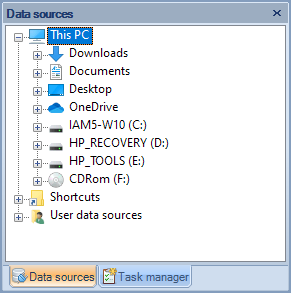
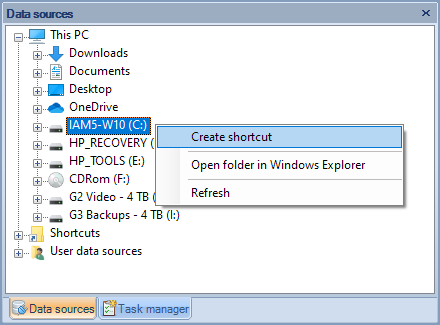
What are the Shortcuts?
The Shortcuts in Spatial Manager Desktop™ are the way you can reference any folder into a physical or net drive, or the drive itself, and allows you quick access to its path. You can access the Shortcuts through the "Data sources" panel
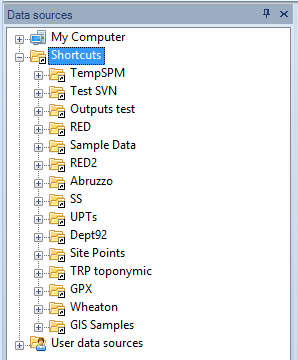
How can I create a new Shortcut?
You can create new Shortcuts in Spatial Manager Desktop™ using the right-click menu over the "Shortcuts" paragraph, in the "Data sources" panel, and typing a path (local or network path) or choosing a folder or drive. You can also create a new Shortcut using the right-click menu over any folder or drive item that you can see in the "Data sources" panel, to reference the path of this folder or drive



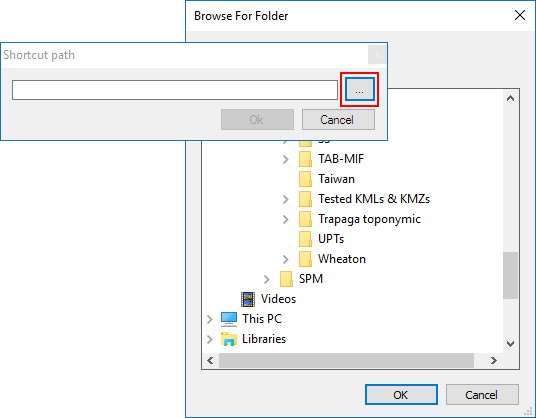
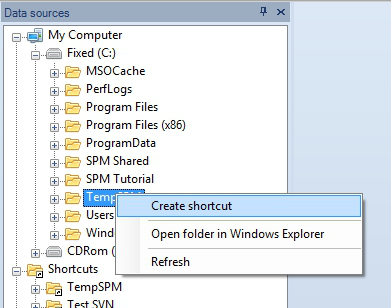
How can I edit a Shortcut?
You can edit a Shortcut in Spatial Manager Desktop™ using the right-click menu over the item, in the "Data sources" panel, to change the path of the folder or drive referenced. You will see a Warning window if the Shortcut is referenced by any Task ("Professional" edition only)
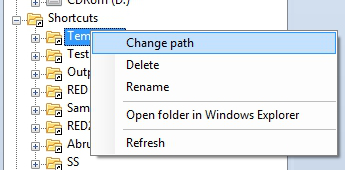
Are there any other functions for the Shortcuts?
Yes, in Spatial Manager Desktop™ you can Delete (you will see a Warning window if the Shortcut is referenced by any Task - "Professional" edition only) or Rename the Shortcut. You can also Refresh the folder or drive content and you can open Windows explorer for the folder or drive referenced by the Shortcut. All these functions are available using the right-click menu over the Shortcut item, in the "Data sources" panel
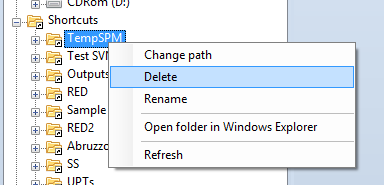
What are the User Data Sources (UDSs)? ("Standard" and "Professional" editions only)
The UDSs in Spatial Manager Desktop™ are the way you can connect with spatial database servers, or data stores, and also the way you can define the path to a particular spatial data file including their own connection parameters. You can access the UDSs through the "Data sources" panel
Usually the access to the data tables into the servers is tedious. Depending on the type of server, you need to enter a lot of connection parameters which are not easy to remember, such as the server name, the user, the password, the connection port, the name of the database, etc. Spatial Manager Desktop™ brings to you the concept of “User Data Source” (UDS), which allows you to store, inside your user settings, all the access parameters for the servers that you regularly connect to, by defining all the parameters once
Files: if you frequently access a file which requires some connection parameters to load it into a Map, export it or use it as part of any Task definition ("Professional" edition only), you may be interested in creating a UDS for this file access, which will also include the connection parameters you choose at the time of defining the new UDS
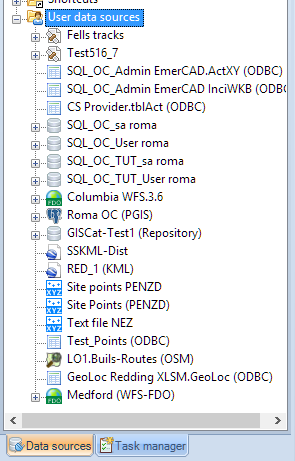
How can I create a new User Data Source (UDS)? ("Standard" and "Professional" editions only)
You can create new UDSs in Spatial Manager Desktop™ using the right-click menu over the "User data sources" paragraph, in the "Data sources" panel, to start the "Create user data source" wizard
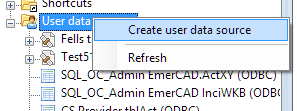
When you create a new UDS to connect with a particular spatial database server, you need to choose the appropriate data Provider for this server, the connection parameters for the server and the name of the UDS. When you create a UDS to access a particular spatial data file, you need to also choose the appropriate data Provider for this file, the file itself, the file parameters and the name of the UDS. All this data is saved, into your application configuration, until you want delete it or modify it. Note that if you choose a read-only data Provider you will be able to read data through this UDS but not to write data
Select a Spatial Manager Data Provider
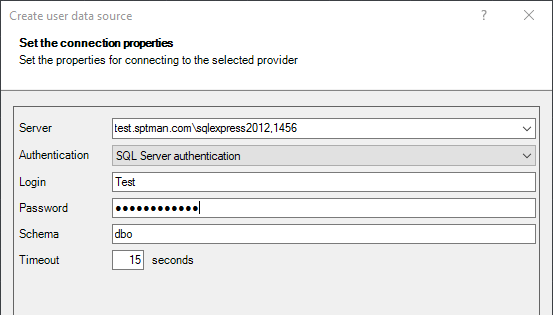
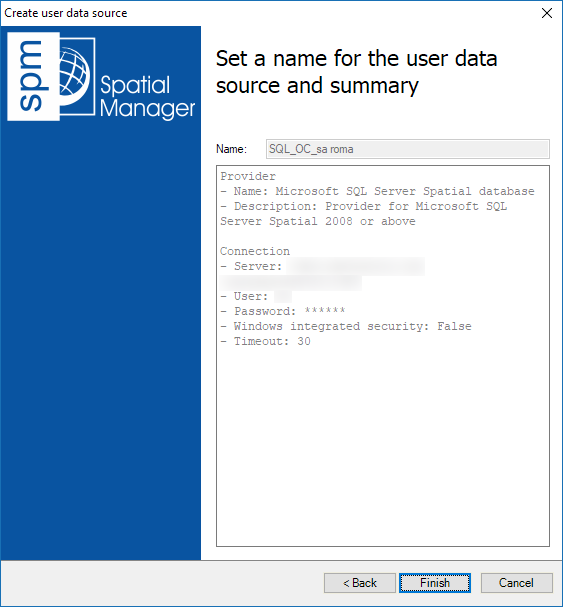
How can I edit a User Data Source (UDS)? ("Standard" and "Professional" editions only)
You can edit a UDS in Spatial Manager Desktop™ using the right-click menu over the UDS item, in the "Data sources" panel, to start the "Create user data source" wizard and to proceed as you see in "How can I create a new User Data Source (UDS)?". The only difference is that the parameters you have entered when you have created the UDS are still there to be edited. You will see a Warning window if the UDS is referenced by any Task ("Professional" edition only)
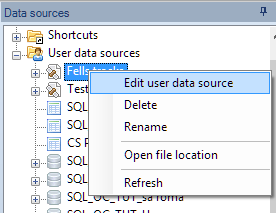
Are there any other functions for the User Data Sources (UDSs)? ("Standard" and "Professional" editions only)
Yes, in Spatial Manager Desktop™ you can Delete (you will see a Warning window if the UDS is referenced by any Task - "Professional" edition only) and Rename the UDS. You can also Refresh the UDS content and, if the UDS is connected to a file, you can open Windows explorer for the folder of the file location. All these functions are available using the right-click menu over the UDS item, in the "Data sources" panel
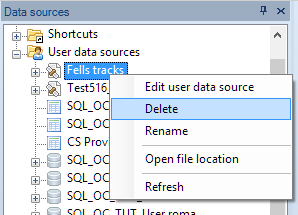
What are the warnings that may appear in the list of User Data Sources (UDSs)? ("Standard" and "Professional" editions only)
When problems occur with any UDS, such as deleted sources, incompatible UDSs, etc., warning messages may appear in the 'Spatial Manager Desktop™' "Data sources" panel that alert you about the problem caused by the corresponding inaccessible UDS


Can I sort the Shortcuts or User Data Sources (UDS) ("Standard" and "Professional" editions only) items in the "Data source" panel?
Yes, to sort any Shortcut or UDS ("Standard" and "Professional" editions only) item in the "Data sources" panel of Spatial Manager Desktop™, you must drag and drop up or down the item itself
How can I recognize each different type of spatial data and its Properties?
To recognize each different type of spatial data, you will see the different icons used for each data Provider in the "Data sources" panel of Spatial Manager Desktop™. In addition, when you select any data source you will see its Properties in the "Properties" panel
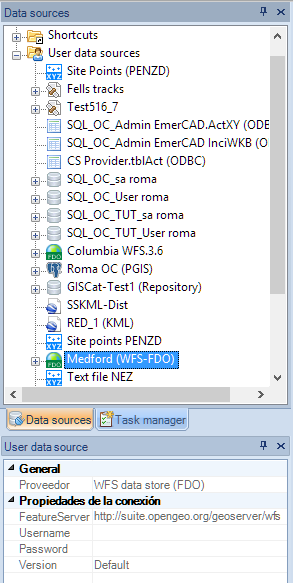
In addition to the Shortcuts and the UDSs ("Standard" and "Professional" editions only), is there some way to access spatial data?
Yes, you can access spatial data files directly through the "My computer" node in the "Data sources" panel of Spatial Manager Desktop™. However, to access spatial databases or spatial stores you should always use UDSs
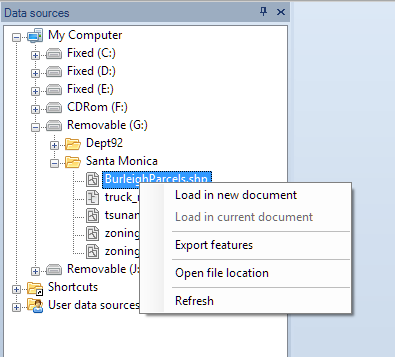
Related links
- See "Providers" also
- Geo-location of addresses using Google Maps APIs
- User Data Sources (UDS) for files. Why use them? ("Standard" and "Professional" editions only)
- How to access ODBC connections ("Standard" and "Professional" editions only)
- Tip – WFS servers return GML data
- New native WFS data provider
- Importing from Excel (CSV or ODBC data providers)